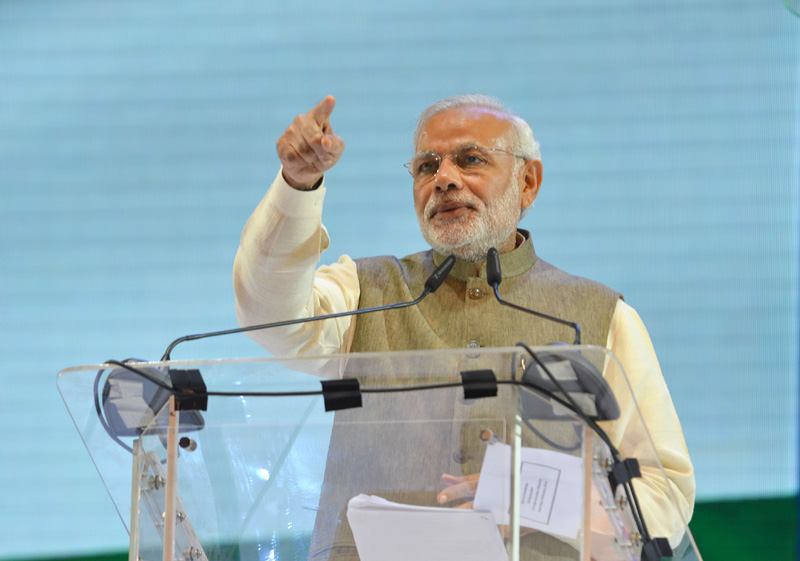 Prime Minister Narendra Modi has made a foreign policy course-correction after realising that the strategic tilt towards the United States has not only grossly upset India’s geopolitical image but also undermined national interests. Indian interests are being particularly affected by the US decision to link its sanctions on Iran and Russia with India, with the Countering America’s Adversaries through Sanctions Act (CAATSA) having the potential to damage India’s defence preparedness. India has decided to defy the US diktat and made it clear that Trump’s “me first approach” is not acceptable and that it would not be guided by any other country on its import of weapons. It has decided to go ahead with the purchase of the Triumf missile and also announced its commitment to follow UN sanctions, not US sanctions on Iran.
Prime Minister Narendra Modi has made a foreign policy course-correction after realising that the strategic tilt towards the United States has not only grossly upset India’s geopolitical image but also undermined national interests. Indian interests are being particularly affected by the US decision to link its sanctions on Iran and Russia with India, with the Countering America’s Adversaries through Sanctions Act (CAATSA) having the potential to damage India’s defence preparedness. India has decided to defy the US diktat and made it clear that Trump’s “me first approach” is not acceptable and that it would not be guided by any other country on its import of weapons. It has decided to go ahead with the purchase of the Triumf missile and also announced its commitment to follow UN sanctions, not US sanctions on Iran.
There has been an overwhelming impression that India is stooping to become a regional ally of the US in the latter’s new strategic theatre of “Indo-Pacific” to keep the sea lanes of communication open, albeit in the pretext of countering China. But moving closer to Washington has been seen as having had a wide-ranging adverse impact. Firstly, it is forcing India to walk a diplomatic tightrope between the US, Russia and China. The policy of intentional ambiguity in conventional terms does play a valuable role, but a prolonged play can also lead to uncertainty, for it can be hard to maintain the balance between coherence and ambiguity. It could also potentially obscure potential harm and threats. Secondly, relying too much on fickle US policies appears risky. As can be seen on the trade front, Trump is backing out on his commitments to other US friends and allies. And there is a lurking feeling that the US was not forthcoming in articulating clear support for India during the Doklam standoff. Thirdly, closer military ties with the US could draw India into a larger political quagmire in terms of attracting the attention of global Islamic terrorist groups which are committed to undermining the interests of America and its allies wherever possible. And, lastly, the process could eventually result in the US making a Pakistan (a long-time client state or banana republic) out of India and the attendant loss of standing in the world as a great nation.
Atop all challenging issues lies the escalating trade conflict between New Delhi and Washington. India has decided to retaliate against the US by increasing import tariffs on 30 American products amounting to $240 million. This is in response to the US imposing tariffs on aluminium and steel imports from India in March 2018. But Donald Trump has threatened to impose further retaliatory import duties on Indian products. The US trade deficit of $21 billion with India is a sore point for the Trump administration, which seeks full reciprocity in trade ties. Any move by Washington to levy retaliatory tariffs would hit India’s exports to the US market. With nearly 16 per cent of India’s total exports going to the US, further and more expansive US tariffs would have implications for the political environment especially when general elections are around the corner and public discontent is rife.
So far, Indo-US trade frictions have remained at the level of posturing only. For example, among the notable items on which the import duty has been raised by India include US products likeHarley-Davidson motorbikes. These retaliatory ‘protectionist’ measures seem simply symbolic in nature and are not comparable to the US-China trade war. While trade issues could still be resolved through dialogue, any escalation of retaliatory steps could widen the friction and even spill over into other areas of cooperation.
The recent talks between Commerce Minister Suresh Prabhu with US Secretary of Commerce Wilbur Ross and US Trade Representative Robert E. Lighthizer have failed to resolve the trade dispute. The abrupt postponement of the first 2+2 dialogue between India and the US, earlier scheduled for July 6, appeared to have everything to do with the issues of trade and sanctions, among others.
The above issues have probably triggered a change in New Delhi’s thinking, for they not only caused serious unease in India but also upset its strategic calculations.
Russian Displeasure
Obviously, the Russians couldn’t have been pleased with India switching over to the American military supply chain system. However, Moscow hasn’t made this a critical issue and continues to transfer the most sensitive strategic armaments to India – although it could have virtually brought the entire Indian defence system to its knees by stopping its supply chain including spares.
What really appears to have miffed Russia was India’s decision to forego its strategic balance by joining the ‘Quadrilateral’ talks with the US, Australia and Japan since 2017. India’s steps to joining this bloc-type security architecture in the ‘Indo-Pacific’ has evidently raised hackles in Moscow, with Foreign Minister Sergei Lavrov strongly advising India to stick to “non-bloc principle”. Putin too was obviously not convinced that India’s role in the ‘Quad’ isn’t about aligning against Russia. In Sochi, he had obliquely reminded Modi of the obligation the two countries share under the “special and privileged strategic partnership” in “military, security and nuclear energy fields”.
China has been scornful of India joining the US bandwagon. Foreign Minister Wang Yi dismissed the ‘Quad’ and ‘Indo-Pacific” formulations as only “headline-grabbing’’ ideas soon to “dissipate” like the “foam on the sea’.
New Delhi seems to have realised the mistake of prematurely denouncing the traditionally followed multi-engagement foreign policy or a “balancing” approach in the global system, even though conceding a space for the US had begun in 2001 when Vajpayee offered Indian bases for US military operations in Afghanistan and Advani wished to send a division to Iraq in 2003. Prime Minister Modi’s “informal” meeting with President Xi Jinping in Wuhan and “agenda-less” talks with President Vladimir Putin in Sochi proved a masterstroke and turning point for his diplomacy.
In particular, Modi’s keynote speech at the Shangri La Dialogue in Singapore seemed a calibrated move to prevent India falling into a dangerous geopolitical trap vis-à-vis US, Russia and China. The subtext of the speech was to reaffirm India’s commitment to multi-polarity, uphold the principles and values of peace and progress, and fight against “global dominance”. The world knew that India was as a power bloc in itself with nations around the world looking up to New Delhi for guidance and support. Modi’s Singapore speech was welcomed by every country including China.
Importantly, Modi avoided making a reference to the ‘Quad’ in Singapore and instead spoke out strongly against “protectionism” – an oblique reference to the Trump policy. Although he praised the US “Indo-Pacific” strategy, he also made it clear that India does not see it “as a club of limited members (or) as a grouping that seeks to dominate” which strongly implied that India is not seeing it as an alliance system. In fact, when US officials described India as the “fulcrum” of or “central” to US Indo-Pacific strategy, Modi deflected the idea by affirming the centrality of the Association of Southeast Asian Nations (ASEAN).
The Prime Minister played down the China threat except for exhorting Beijing to play by the rules, saying an “Asia of rivalry” would hold all its players back. And, in contrast to US Defense Secretary James Mattis warning China over maritime ‘intimidation’, Modi talked about seeking closer ties with China and termed “stable relations” between the two countries as “an important factor for global peace and progress.” Modi went a step further and advised other powers to avoid taking a confrontationist line to prevent “great power rivalries”. These statements were significant given that they were made about a week ahead of the Shanghai Cooperation Organisation (SCO) summit in Qingdao. At Qingdao, he joined other leaders in committing to the “Shanghai Spirit” – a term coined in 2006 to invert the Cold War-era mentality.
India’s Options
New Delhi needs to be mindful of the fluid nature of the dynamics in security relationships in the Asia-Pacific. Indian interlocutors seeking exemptions from higher tariffs on Indian items in the US market need to understand that Trump is likely to agree to such a step only if he is able to make enough profits by selling US arms to India. This explains the US attempts to scuttle India’s ongoing defence deals with Russia. Trump knows that America can sell India a glut of arms by playing up Indians’ Sinophobia.
Though his dexterous diplomacy, Modi has deflated the hype created by certain sections of Indian and American think tanks and media outlets which enjoyed a great sense of vanity and smugness about the strategic importance of India for America in counterbalancing China.
To be clear, there can’t be an Asia without China just as there can’t be an Asia without India. In fact, most Asian nations, despite their disputes and differences, do not approve of all-round hostility against each other.
Instead, India’s fellow Asian societies seemed to have learnt and continue to practice Nāgārjuna’s non-dogmatic precept of Madhyamaka (fundamental verses of the Middle Way) that accepts the nature of reality and ‘interdependent co-arising or dependent co-origination’ to overcome problems.
Realising that India can no longer continue with the old habit of remaining a geopolitical bystander in Asia, a nuanced shift in Modi’s policy of moving away from the West-led confrontationist approach is a welcome move. What Modi essentially lacked until recently was a wise and level-headed foreign policy advisor.
Yet, one should be cautiously optimistic about the Wuhan process moving forward in the right direction. Possibly it does not represent a change of hearts but only a tactical adjustment with both sides buying a temporary truce due to the imperatives of their respective external and domestic agenda. For the overall atmosphere of suspicion and mistrust to go will take time and require sustained efforts by both sides. But the process of resetting the ties may have begun in Wuhan, probably with India’s willingness to stop playing the Dalai Lama card in return for China’s willingness to end using Pakistan as a proxy. India should try and avert further challenges posed by China from multiplying. One hopes that the new team led by Foreign Secretary Vijay Gokhale is able to navigate engagement with China in good faith and not indulge in tactical ploys.
Courtesy: https://idsa.in/idsacomments/averting-india-fall-into-a-geopolitical-trap-pstobdan-060718




